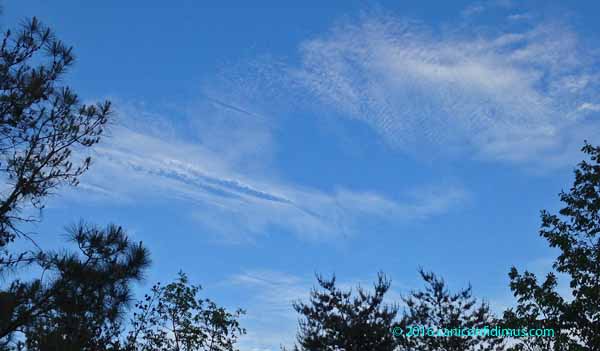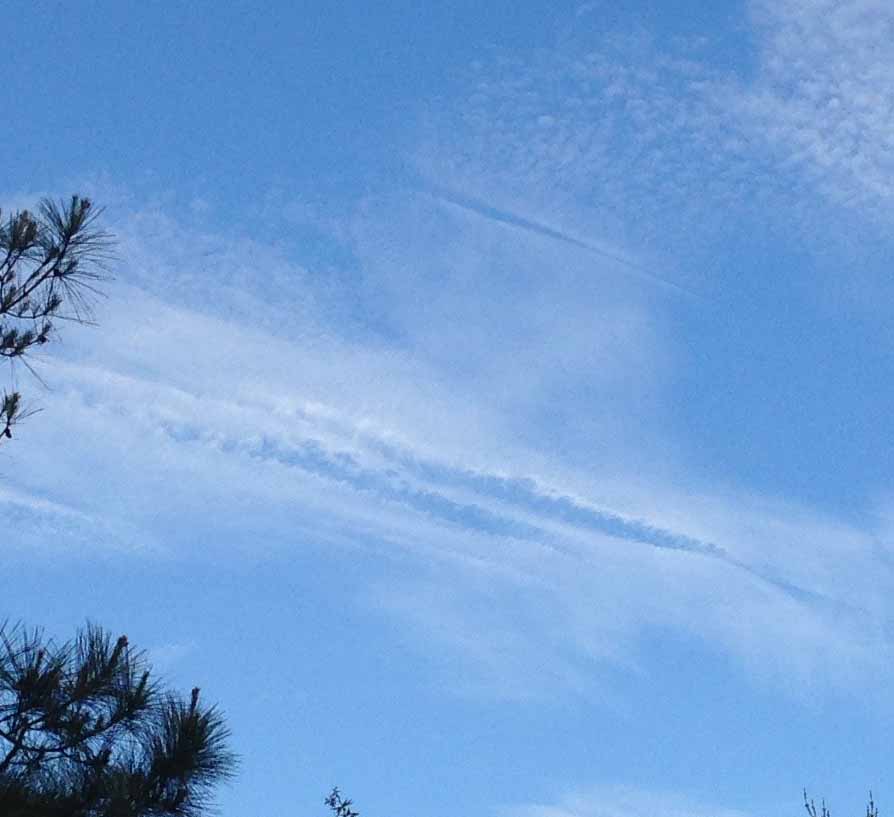We saw some nice clouds when we took the dogs out for an evening walk Wednesday.

There were some waves and a couple of interesting features associated with the passage of high-altitude airliners. Just to the left of center there are two dark, linear features that are probably, but not certainly, contrails. If that’s what they are, they are probably old (where old means more than a few minutes). They look dark because we’re looking at the under, shaded side. They may not be contrails at all, just linear cloud features.
Just above them, however, is what appears to be a negative contrail, a linear feature of apparently clear air within a cloudy region of the sky. This is more likely to be an artifact of the passage of an airliner. A negative contrail is also called a distrail, or dissipation trail. Here’s a little closer look.

In searching around for an explanation for distrails, I found at least two. One is that the warm exhaust of a jet engine warms the air in the cloud, causing existing cloud droplets or ice crystals to evaporate. A second is that the small particulates in a jet exhaust become condensation nuclei which cause large enough droplets or ice crystals to form that they precipitate out of the cloud, leaving behind a clear region. The website with this particular explanation alternatively attributes the effect to the turbulence created by the aircraft’s passage causing greater condensation and precipitation. Other explanations don’t mention turbulence; I think it’s possible that under the right conditions, turbulence might cause a wake of sorts to appear in a cloud that looks like a negative contrail. I think that’s a different phenomenon from the particulate-condensation nuclei-precipitation explanation.
I think the second explanation (particulates-condensation nuclei-precipitation) is probably closer to right, and the warm air-evaporation explanation is wrong. My reasoning is that the same conditions that cause a condensation trail to form are being blamed for an evaporation trail. The warm (or hot, if you will) exhaust of a jet engine very quickly cools as the gases expand, which causes the water vapor it contains to condense, thus forming a contrail. I can’t think of a way that adding water vapor to air will cause evaporation.
The accuracy of the second explanation is bolstered by accounts of seeing virga or falling ice crystals from the region of the distrail.
A third explanation includes some atmospheric optics along with the particulates-condensation nuclei-precipitation process that may or may not be necessary to the explanation of distrails. It relies on optical properties of ice versus water as well as on precipitation. If anyone is interested they can check out the site, which some readers are already familiar with.
On other days in other skies, I have seen what looks like a negative contrail, but these are usually a visual effect. What looks like a negative contrail in those cases is actually the shadow of a higher contrail falling onto a lower cloud deck. It’s sometimes hard to tell the difference because the lower cloud deck can hide the higher contrail, so all you see is a dark trail through the clouds that looks a lot like a view through the cloud to clearer sky.
In this case, I think what Leah and I saw was actually a distrail.